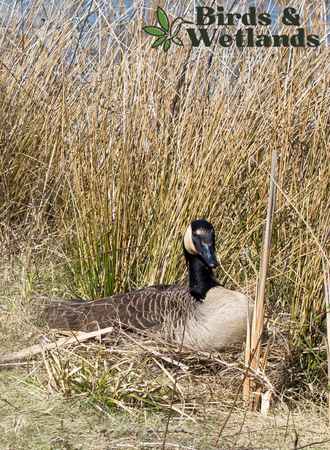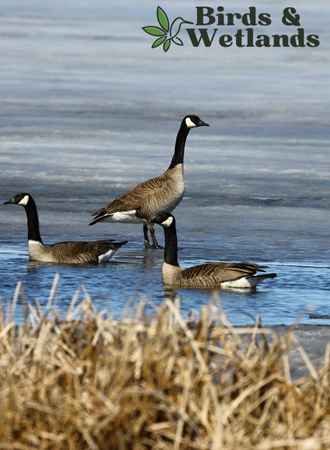As winter draws near, many animals begin to prepare for the long cold months ahead. For geese, this means finding a mate. Goose breeding season typically extends from mid-winter to early spring.
During this time, male and female geese engage in courtship behavior as a way of showing interest in each other. In this blog post, we will take a closer look at the breeding season and the mating behavior of the goose.
Key Points
The female makes the decision on nest site location, constructs the nest, and incubates the eggs.
Due to climate change and habitat recreation, more geese have settled and built nest sites in urban areas.
Geese prefer to nest in areas where approaching predators can be easily seen.
The breeding season of most geese typically starts from mid-winter to early spring.
Canada geese mate for life and return to the same nesting site year after year.
As the female incubates the eggs, the male stands guard at a short distance away from the nest.
How do you know that geese mating season is in full swing?
There are a few telltale signs that the geese mating season has begun. To begin, you may notice more loud honking and other noisy behaviors. This is because male geese use their loud calls to attract mates and warn other males not to approach the females.
Additionally, aggressive behavior may be observed as males compete for the attention of females. The female will pick her mate based on courtship displays.
There will also be fewer geese in wildlife management areas and refuges.

Do Canada geese return to the same nesting sites each year?
Canada geese mate for life and return to the same nesting site year after year. These sites are usually near water, as geese need water access for drinking and bathing.
Males usually arrive at the nesting site first, followed by females a few weeks later. A mated pair may copulate at least five times per day during the breeding season.
Once the pair has reunited, they will build a nest using grasses, twigs, and feathers. She will also add body feathers and down, usually after the second egg is laid.
Where are Canada geese’ nest sites usually located?
Canada Geese typically nest in an elevated area, bushes, or raised areas of land near fresh water sources. The female will build the nest using materials such as a large mound of vegetation, down feathers, mud and other soft plant material.

Where does the giant Canada goose breed?
The giant Canada goose (Branta canadensis maxima) is a subspecies of the Canada goose or Canadian goose. They breed in the northern parts of the United States and southern regions of Canada.
The Indiana population breeds in the wild in freshwater wetlands and along slow-moving streams. Farm ponds and man-made lakes are preferred breeding habitats as long as aquatic vegetation is abundant for nesting.
Small groups of these geese often nest together in loose colonies on manicured lawns adjacent to their breeding sites.
What does the male goose do while the female is incubating its eggs?
Once the female goose has laid their eggs, incubation of goose eggs begins. The female goose carefully arranges herself over the eggs, using her body heat to keep them warm.
During the incubation period, the male goose stands guard a distance away from the nest. His job is to make sure that no predators come too close and put his mate or future offspring in danger.
He often calls out to warn her of any approaching danger. Once eggs hatch, he helps care for them until they’re old enough to fend for themselves.

Are Canada geese monogamous?
Many species of animals mate for life, and Canada geese are one of the most well-known examples. Canada geese mate for life, and if one of the pair dies, the surviving goose may mourn its loss.
Usually, the mourning process can take at least two years until the next mating season but in some cases it may last for more than that.
Eventually, the surviving goose will often find another mate and start a new life with them. While this may seem cold-hearted to humans, it is simply how these creatures have evolved to ensure their survival.
By remaining monogamous, Canada geese can ensure that their young have two parents to care for them and help them thrive.
Do Canada Geese stay in family groups?
Canada geese are highly social animals that live in families. Families are typically made up of a pair of geese and their offspring. The parents raise their children until they are mature enough to mate. When the children reach adulthood, they leave their family group and seek out new friends.
Surprisingly, family size influences the determination of dominance in goose populations. Large families outnumber small families, and any size family outnumbers paired or unpaired birds without families. This structure ensures that each goose has access to the resources required to survive and thrive.
Once goslings begin to fly, they form what are called gang broods. A gang brood can have 20 to 100 goslings following only a few adults.

When do adult geese with goslings molt?
Molting is an essential part of the life cycle of a goose. When a bird molts, it sheds its flight feathers and grows new ones. Molting occurs once a year in geese, usually in the late summer or early fall.
Adult geese with goslings, on the other hand, will molt at the brood-rearing area shortly after non-breeding geese begin their molt. This allows the adults to regain flight about the same time as their young, usually around 70 days after hatching.
To avoid danger, Canada geese molt in open areas near water and a food source, putting themselves within walking distance of food and providing an unobstructed view.
Molting is a stressful time for geese because they are vulnerable while unable to fly. It is, however, a necessary process that helps them stay healthy and prepare for the next stage of their life cycle.
How do you deal with nesting geese?
Nowadays, it’s pretty common to see large flocks of geese nesting at golf courses and other urban environments. You may never have to deal with a nesting goose if you’re lucky.
These larger birds can be fiercely protective of their young, and they are known to attack humans who come too close to their nests. It’s best to avoid geese altogether during the nesting season, but if you need to deal with them, there are some ways to do this.
One way is to provide a visible barrier between the nest and people. This can be something as simple as a row of potted plants or a snow fence. If the nest is located near the entrance to an office or store, this can help deter people from getting too close.
Another option is to contact your local wildlife agency for help in relocating the nest. However, it would help if you only did this as a last resort, as it can be stressful for the birds.

When do Canada geese start breeding?
Most Canada geese naturally start to mate once the birds are at least 4 years of age. Pairs of geese before that point are often unstable.
However, there have been documented cases of extra-pair copulations between young birds that were younger than four years old. Once breeding does begin, it usually happens on an annual basis.
When do Chinese geese mate?
Chinese geese, which are much smaller than European breeds, usually mate in late February to early May.
After mating with a gander, the female goose lays a clutch of 10 to 15 eggs. The hatching process or gestation period takes between 28 and 35 days. Within ten weeks of birth, the goslings can fly.
Chinese geese typically form bonds with other geese in their flock and mate for life. These birds are gregarious and prefer to spend time in groups. They are also fiercely protective of their young and will defend their nests fiercely if necessary.
Artificial insemination is a popular method for efficiently breeding domestic geese such as the Chinese geese.
If your geese are not naturally breeding or you want to improve the efficiency of breeding, you can artificially inseminate your geese. The process is relatively simple and only requires a small amount of equipment.



